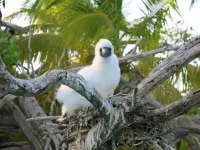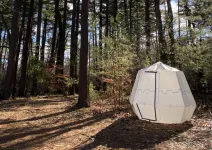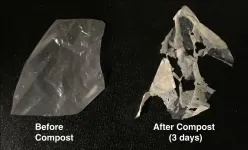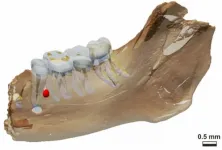Central African forests are unequally vulnerable to global change
2021-04-21
(Press-News.org) Central Africa is home to the world's second-largest area of dense tropical rainforest. This major reservoir of biodiversity stretches out over five main countries: Cameroon, Gabon, the Republic of Congo, the Democratic Republic of Congo and the Central African Republic. It provides numerous ecosystem services, such as regulating exchange cycles between the earth and the atmosphere, and helps to ensure food supply for local populations. Due to the threats from climate change and demographic pressure expected in Africa by the end of the 21st century, the protection and sustainable management of these forests is a challenge for policy makers. It requires better knowledge of these ecosystems, in particular their composition and vulnerability to the changes under way.
Mapping forest composition and vulnerability
During the study, the researchers worked with forestry consultants and logging companies to compile a new inventory dataset of 6 million trees on over 185,000 plots of land. They first modelled and mapped the floristic and functional composition of Central African forests and calculated their vulnerability, taking account of the different climate scenarios of the Intergovernmental Panel on Climate Change (IPCC) and the United Nations' population projections for the end of the century.
"The forest area of Central Africa is far from being a homogeneous green carpet. It is home to a wide variety of forests with different characteristics, including their own particular carbon storage capacity," explains Maxime Réjou-Méchain, an ecologist at IRD and first author of the study. "This diversity can be explained by the different types of climate (humidity, temperature, evapotranspiration rate, amount of rainfall) and soils, as well as by the history of the African flora and the degree of human activity that has disturbed the forests for thousands of years, such as shifting agriculture".
The researchers then showed that some areas may be more sensitive to climate change than others. For example, "the forest margins in the north and south of the region, the Atlantic forests and most of those in the Democratic Republic of Congo, which is home to more than half of Central Africa's forests, are among the most vulnerable" explains Professor Bonaventure Sonké, a botanist at the University of Yaoundé 1 and co-author of the study.
Improving strategies for adaptation to climate change
The maps and data used for this study, available online on the Cirad data repository, provide useful information for scientists on the functioning of forests and their dynamics and carbon storage potential.
"The diversity of forest types in Central Africa offers a wide range of potential responses to global changes. It is therefore an essential element to take into account in the framework of sustainable management policies and the fight against climate change", says Pr. Alfred Ngomanda, an ecologist at CENAREST (Gabon) and co-author of the study.
"These results must now be used and applied to develop land use plans that preserve forest characteristics while maintaining connections between protected zones through sustainably managed timber production forests. In places where human pressure is too great, managers could re-establish these connections through biodiversity restoration programmes or the development of agroforestry", concludes Sylvie Gourlet-Fleury, a forest ecologist at CIRAD and one of the main coordinators of the study.
INFORMATION:
[Attachments] See images for this press release:
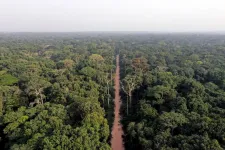
ELSE PRESS RELEASES FROM THIS DATE:
2021-04-21
The disastrous consequences of climate "tipping points" could be averted if global warming was reversed quickly enough, new research suggests.
Once triggered, tipping points may lead to abrupt changes such as the dieback of the Amazon rainforest or melting of major ice sheets.
Until now, crossing these thresholds has been assumed to be a point of no return, but the new study - published in the journal Nature - concludes that thresholds could be "temporarily exceeded" without prompting permanent shifts.
The research team, from the University of Exeter and the UK Centre for Ecology and Hydrology (UKCEH), say the time available to act would depend on the level ...
2021-04-21
Scientists have provided the first evidence to show that eradicating rats from tropical islands effects not just the biodiversity on the islands, but also the fragile coral seas that surround them.
The new study led by scientists at Lancaster University and published in the journal Current Biology shows that critical cycles of seabird nutrients flowing to coral reefs are re-established within relatively short time periods after rats are removed - even around islands that have been infested for hundreds of years.
The findings offer encouragement that rat eradication can benefit coral ...
2021-04-21
What The Study Did: Researchers looked at whether short-term exposure to air pollution from a 2018 California wildfire was associated with changes in the number of clinic visits for eczema or itch and medications prescribed for eczema.
Authors: Maria L. Wei, M.D., Ph.D., of the University of California, San Francisco, is the corresponding author.
To access the embargoed study: Visit our For The Media website at this link https://media.jamanetwork.com/
(doi:10.1001/jamadermatol.2021.0179)
Editor's Note: The article includes conflicts of interest and funding/support disclosures. Please see the article for additional information, including other authors, author contributions and affiliations, conflict of interest and financial disclosures, ...
2021-04-21
Wildfire smoke can trigger a host of respiratory and cardiovascular symptoms, ranging from runny nose and cough to a potentially life-threatening heart attack or stroke. A new study suggests that the dangers posed by wildfire smoke may also extend to the largest organ in the human body, and our first line of defense against outside threat: the skin.
During the two weeks in November 2018 when wildfire smoke from the Camp Fire choked the San Francisco Bay Area, health clinics in San Francisco saw an uptick in the number of patients visiting with concerns of eczema, also known as atopic dermatitis, and general itch, compared to the same time of the year ...
2021-04-21
A mechanistic understanding of brain development requires a systematic survey of neural progenitor cell types, their lineage specification and maturation of postmitotic neurons. Cumulative evidences based on single-cell transcriptomic analysis have revealed the heterogeneity of cortical neural progenitors, their temporal patterning and the developmental trajectories of excitatory and inhibitory neurons in the developing neocortex. Nevertheless, the developmental hierarchy of the hypothalamus, which contains an astounding diversity of neurons that regulate endocrine, autonomic and behavioral functions, has not been well understood.
Recently, however, Prof. WU Qingfeng's ...
2021-04-21
WHO Peter Libby, MD, cardiovascular medicine specialist at Brigham and Women's Hospital and the Mallinckrodt Professor of Medicine at Harvard Medical School; author of a new review paper published in Nature.
WHAT Atherosclerosis -- hardening of the arteries -- is now involved in the majority of deaths worldwide, and advances in our understanding of the biology of the disease are changing traditional views and opening up new avenues for treatment.
The picture of who may be at risk for a heart attack has evolved considerably in recent decades. At one time, a heart attack might have conjured up the image of a middle-aged white man with high cholesterol and high blood pressure who smoked cigarettes. Today, traditional concepts of what contributes to risk have changed. These ...
2021-04-21
In 2016, an inflatable arch wreaked havoc at the Tour de France bicycle race when it deflated and collapsed on a cyclist, throwing him from his bike and delaying the race while officials scrambled to clear the debris from the road. Officials blamed a passing spectator's wayward belt buckle for the arch's collapse, but the real culprit was physics.
Today's inflatable structures, used for everything from field hospitals to sporting complexes, are monostable, meaning they need a constant input of pressure in order to maintain their inflated state. Lose that pressure and the structure ...
2021-04-21
What is the cost of 1 ton of a greenhouse gas? When a climate-warming gas such as carbon dioxide or methane is emitted into the atmosphere, its impacts may be felt years and even decades into the future - in the form of rising sea levels, changes in agricultural productivity, or more extreme weather events, such as droughts, floods, and heat waves. Those impacts are quantified in a metric called the "social cost of carbon," considered a vital tool for making sound and efficient climate policies.
Now a new study by a team including researchers from Lawrence Berkeley National Laboratory (Berkeley Lab) ...
2021-04-21
Despite our efforts to sort and recycle, less than 9% of plastic gets recycled in the U.S., and most ends up in landfill or the environment.
Biodegradable plastic bags and containers could help, but if they're not properly sorted, they can contaminate otherwise recyclable #1 and #2 plastics. What's worse, most biodegradable plastics take months to break down, and when they finally do, they form microplastics - tiny bits of plastic that can end up in our oceans, fish, and even our bodies.
Now, as reported in the journal Nature, scientists at the Department ...
2021-04-21
A study that appeared today on Current Biology sheds new light on the continental migrations which shaped the genetic background of all present Europeans. The research generates new ancient DNA evidence and direct dating from a fragmentary fossil mandible belonging to an individual who lived ~17,000 years ago in northeastern Italy (Riparo Tagliente, Verona). The results backdate by about 3,000 years the diffusion in Southern Europe of a genetic component linked to Eastern Europe/Western Asia previously believed to have spread westwards during later major warming shifts.
"By looking into the past of this particular individual, ...
LAST 30 PRESS RELEASES:
[Press-News.org] Central African forests are unequally vulnerable to global change

